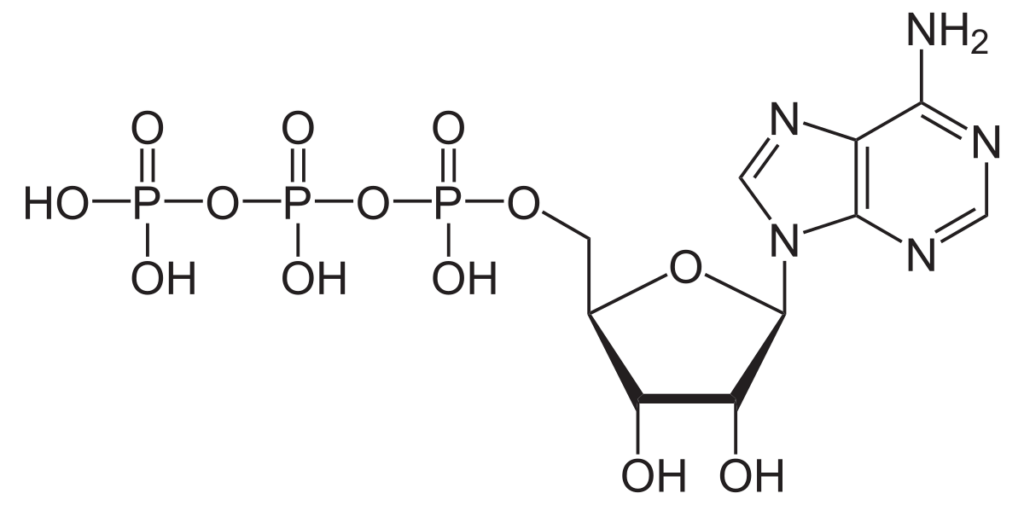ATP FULL FORM: What is ATP and How Does it Work?
Adenosine triphosphate, or ATP, is a molecule that serves as the primary energy source for all living organisms. It is often referred to as the “molecular currency” of the cell because it provides the energy necessary for cellular processes such as metabolism, muscle contraction, and protein synthesis. In this article, we will explore the ATP full form and delve deeper into the workings of this vital molecule.
Read Other Full Forms
What is ATP Full Form?
ATP is an organic compound that is found in all living organisms. It is made up of three main components: a nitrogenous base called adenine, a five-carbon sugar called ribose, and three phosphate groups. ATP is produced in the mitochondria of cells through a process called cellular respiration. The energy that is released during the breakdown of glucose is used to add a phosphate group to adenosine diphosphate (ADP), forming ATP.
ATP Structure
The structure of ATP is critical to its function as an energy molecule. The nitrogenous base adenine is attached to the sugar ribose, which is in turn attached to a chain of three phosphate groups. These phosphate groups are the key to ATP’s ability to store and release energy. When ATP is broken down into ADP, one of the phosphate groups is removed, releasing energy that can be used by the cell.

How is ATP Produced?
ATP is primarily produced through cellular respiration, a process that occurs in the mitochondria of cells. During cellular respiration, glucose is broken down into carbon dioxide and water, releasing energy that is used to add a phosphate group to ADP, forming ATP. In addition to cellular respiration, ATP can also be produced through photosynthesis in plants.
ATP Hydrolysis
ATP can be broken down into ADP through a process called hydrolysis. When one of the phosphate groups is removed from ATP, energy is released that can be used by the cell. The resulting molecule, ADP, can then be recharged with another phosphate group to form ATP, and the process can start again.
ATP and Cellular Processes
ATP is essential for many cellular processes, including muscle contraction, protein synthesis, and metabolism. It serves as a source of energy that can be quickly used by the cell to power these processes.
ATP and Muscle Contraction
Muscle contraction requires ATP to provide the energy needed for the movement of muscle fibers. When a muscle is stimulated, ATP is broken down into ADP, releasing energy that causes the muscle fibers to contract. This process is repeated over and over again, providing the energy necessary for sustained muscle movement.
ATP and Protein Synthesis
Protein synthesis, the process by which proteins are made in the cell, also requires ATP. ATP is needed to provide the energy necessary for the formation of peptide bonds between amino acids, which are the building blocks of proteins.
ATP and Metabolism
Metabolism is the set of chemical reactions that occur in the cell to maintain life. Many of these reactions require energy, which is provided by ATP. ATP is involved in both anabolic (building up) and catabolic (breaking down) metabolic pathways.
ATP and Photosynthesis
In addition to cellular respiration, ATP can also be produced through photosynthesis in plants. During photosynthesis, light energy is used to convert carbon dioxide and water into glucose and oxygen. The energy that is released during this process is used to add a phosphate group to ADP, forming ATP.
ATP and Respiration
Respiration is the process by which cells break down glucose to release energy. This energy is then used to power cellular processes, including the production of ATP. There are two types of respiration: aerobic and anaerobic. Aerobic respiration requires oxygen and produces a large amount of ATP, while anaerobic respiration does not require oxygen and produces a smaller amount of ATP.
Importance of ATP
ATP is crucial for the survival of all living organisms. It serves as the primary energy source for cellular processes and is essential for the functioning of cells, tissues, and organs. Without ATP, cells would not be able to carry out the processes necessary for life.
ATP Deficiency
ATP deficiency can lead to a variety of health problems, including muscle weakness, fatigue, and even death. Several conditions can cause ATP deficiency, including mitochondrial diseases and certain metabolic disorders.
ATP Supplements
There are many supplements on the market that claim to boost ATP levels and increase energy. However, the effectiveness of these supplements is not supported by scientific evidence. In addition, some of these supplements may have negative side effects and should be used with caution.
Conclusion
In conclusion, ATP is a vital molecule that serves as the primary energy source for all living organisms. It is produced through cellular respiration and photosynthesis and is involved in many cellular processes, including muscle contraction, protein synthesis, and metabolism. ATP deficiency can lead to serious health problems, and while there are supplements that claim to boost ATP levels, their effectiveness is not supported by scientific evidence.
Frequently Asked Questions
Q.1 What does ATP stand for?
ATP stands for adenosine triphosphate.
Q.2 How is ATP produced?
ATP is primarily produced through cellular respiration, a process that occurs in the mitochondria of cells.
Q.3 What is the function of ATP?
ATP serves as the primary energy source for cellular processes, including muscle contraction, protein synthesis, and metabolism.
Q.4 What happens when ATP is broken down?
When ATP is broken down, a phosphate group is removed, releasing energy that can be used by the cell.
Q.5 Are there supplements that can boost ATP levels?
While there are supplements that claim to boost ATP levels, their effectiveness is not supported by scientific evidence and should be used with caution.

